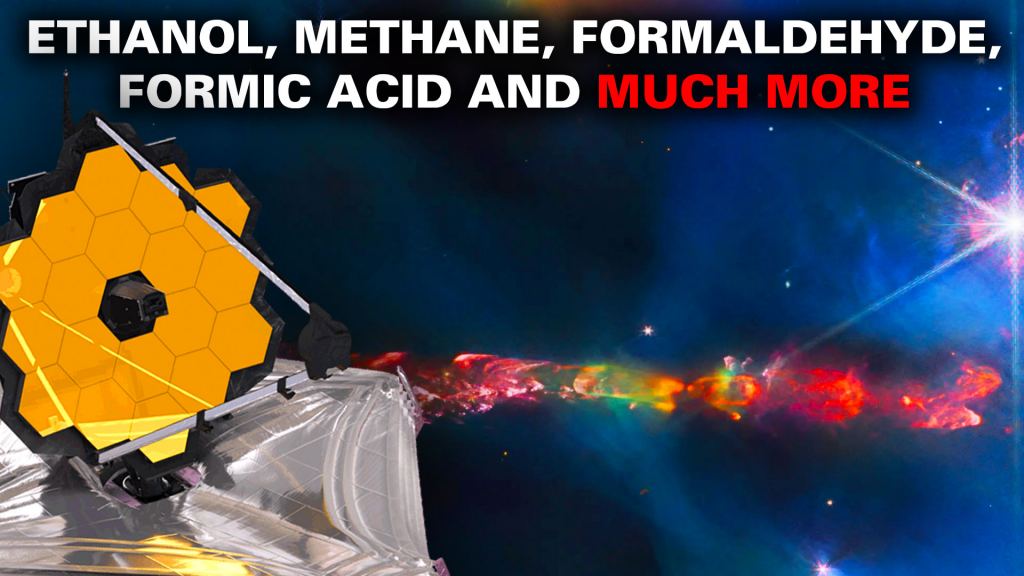In the quest to understand how and where life might arise in the galaxy, astronomers search for its building blocks. Complex Organic Molecules (COMs) are some of those blocks, and they include things like formaldehyde and acetic acid, among many others. The JWST has found some of these COMs around young protostars.
What does this tell astronomers? While the molecules in question are complex and organic, they’re nowhere near as large as terrestrial COMs. For that reason, scientists sometimes call them iCOMs, where i stands for interstellar. iCOMS include simple alcohols, esters, nitriles, and ethers.
To be a COM, a molecule must have at least six atoms, one of which must be carbon. Astronomers have found iCOMs inside star-forming regions, in clumps called hot cores or hot corinos. These cores and corinos give rise to massive and smaller protostars, respectively.
As these protostars form, they also form protoplanetary disks. So, if astronomers can detect iCOMs in these protostars, then they can reasonably expect that they’ll be present in the protoplanetary disk on any rocky planets that might form. That means that there’s a plausible pathway from complex organic molecules around protostars to rocky planets and the potential for life.
Astronomers have found some iCOMS before using radiotelescopes like ALMA and the VLA to see through the surrounding dust. In new research, a team of astronomers examined a pair of young protostars and searched for COMs using the JWST. Their observations are part of the JOYS+ (JWST Observations of Young protoStars) observing program that examined 30 young stars.
The observations were obtained with the JWST’s MIRI and MRS instruments. The researchers examined one high-mass protostar and one low-mass protostar from the 30-star sample. They’re called NGC 1333 IRAS 2A and IRAS 23385+6053, respectively.
NGC 1333 is a star-forming region in the Perseus Molecular Cloud about 960 light-years away. Astronomers have detected COMS in the gas phase around protostars before, but only smaller ones no larger than CH3OH (methanol. ) They expect that these gaseous COMs come from solid phase COMs formed on ice grains, but those are tough to detect.
But like a host of other issues in astronomy and astrophysics, the JWST allows scientists to dig deeper. Its range and sensitivity allow it to detect more icy grain COMs that include oxygen. Oxygen’s significance in the chemistry of life can’t be overstated: there’s no water without it.
The molecular ingredients for life spend a significant amount of time as ices. They become more complex over time through chemical processes depending on their environments. Leiden University maintains an ice database containing infrared spectra for a massive number of astrophysical ice analogs at different temperatures and chemical environments.
It was built partly in anticipation of the launch of the JWST and its powerful infrared capabilities. The JWST’s Ice Age early-release science program is aimed at tracing the building blocks of life as they form and evolve around young stars and protoplanetary disks. Though these findings are from the JOYS+ program, all of these efforts are intertwined.
Through all these efforts, scientists hope to one day have a well-defined understanding of how COMs form and evolve, and how they feed into the appearance of life. “They are intrinsically important to comprehend the chemical complexity developed in star-forming regions since these materials are the feedstock for future exoplanetary systems,” the researchers write in their paper. “Once available in primitive planetary systems, this material can potentially promote the habitability of planets.
” This new research will appear in the journal Astronomy and Astrophysics. The paper is “ JWST Observations of Young protoStars (JOYS+): Detection of icy complex organic molecules and ions. I.
CH4, SO2, HCOO?, OCN?, H2CO, HCOOH, CH3CH2OH, CH3CHO, CH3OCHO, CH3COOH. ” The lead author is W. R.
M. Rocha from the Leiden Observatory in the Netherlands. .
From: universetoday
URL: https://www.universetoday.com/164802/webb-finds-icy-complex-organic-molecules-around-protostars-ethanol-methane-formaldehyde-formic-acid-and-much-more/



